Click to email me
July 10th 2004 - The Final Parade Of
Captain Walker's Old Boy's Association On The Occasion Of The Laying Up Of The Standard
and handing over to Liverpool of the statue of Captain Walker RN
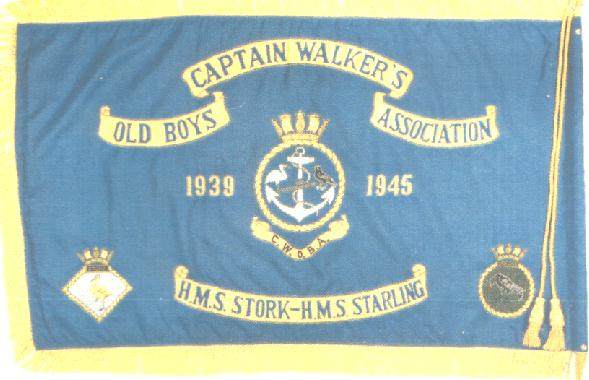
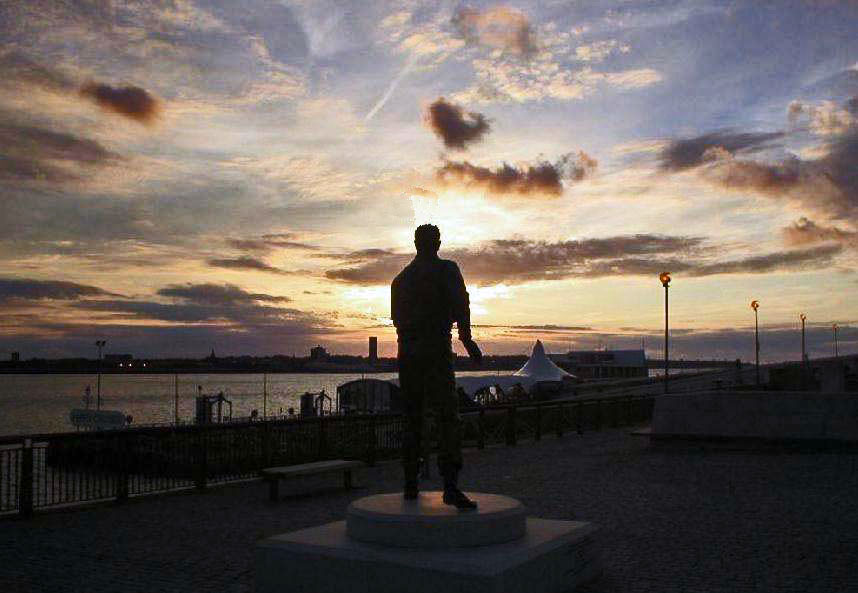
| On the 60th Anniversary of Captain Johnnie Walker's death I arrived in Liverpool to attend the following day's Laying Up of the Standard of Captain Walker's Old boys Association. This was to be the lads final parade as numbers were sadly dwindling and the journey to the Association functions was taking its toll on the surviving gentlemen involved. The standard was to be laid up in Bootle Town Hall following a service in St Nicholas' church on the Pier Head, the sailors church of Liverpool. Bootle Town Hall is unique, probably very few are so mindful still of the supreme sacrifice and hardships involved in keeping our vital sea lanes open during the Battle of the Atlantic 1939 - 1945. That these lads were instrumental in this great victory is recorded on the other pages dedicated to Capt Walker and his crews. In the Town Hall are displayed many memorabilia giving due tribute to the close ties with the men and women of the Royal Navy, in particular during World War 2 when Bootle's docks, in particular Gladstone Dock, hosted the men of Captain Walker's small fleet of Black Swan Class Sloops. Banners, flags and bells adorn the walls of the Council Chamber, as well as plaques and images of these and other great fighting ships. It is to the honour of the Lord Mayor of Sefton, Councillors and the people of Bootle that this honour is likely to last for many many years to come. In the words of Johnnie Walker's grandson, Captain Patrick Walker, "probably until the standards disintegrate from sheer age!" Ray Holden and Lionel Irish, accompanied by their long suffering wives, were present to make some further presentations in honour of one of Walker's Own - HMS Kite. The roll of honour will be displayed along with plaques to commemorate, in perpetuity, the gallant lads of this fine ship. Also Ray Holden personally presented to Captain Patrick Walker a large plaque "for his safe keeping" of the crest of HMS Kite suitably inscribed, a picture of which can be found below. Events such as these are becoming all the more valuable due to the relentless passage of the years. These lads can not stay with us forever and they deserve the due honours we, the present generations, bestow upon them. All over the Town Hall can be found particular items commemorating this Fighting Captain and his equally heroic sailors. Here then are the images taken by me over the two days I spent, back on Merseyside where I grew up, of the events and the peripheral visit to the Liverpool Maritime Museum (Ray, Lionel, Jerome McAreavey & myself) and the coming together of people who had previously only been in contact with me via email. See below for a brief history of St Nicholas' Church. | |
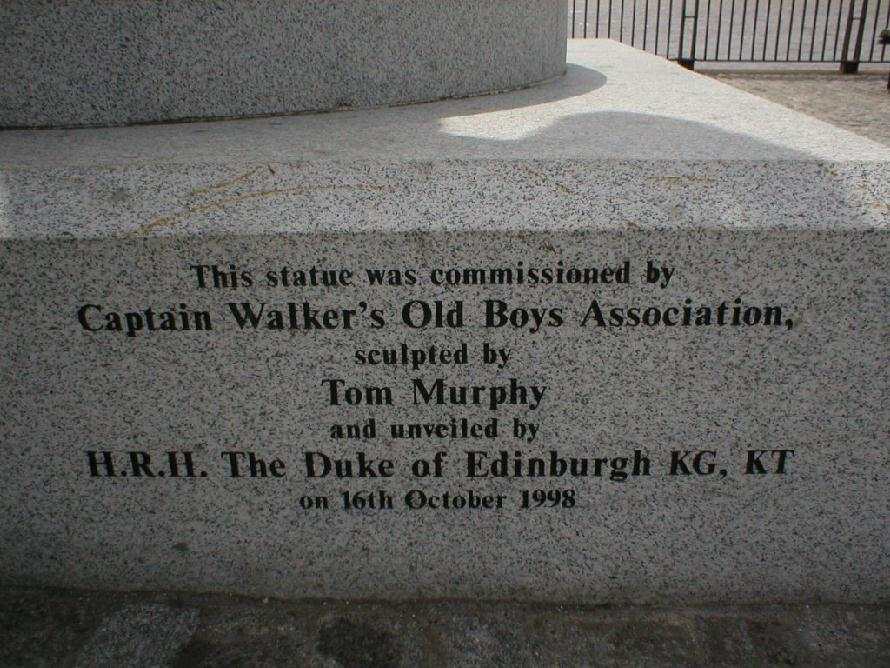 One of the inscriptions on the base of the statue of Captain Johnnie Walker |
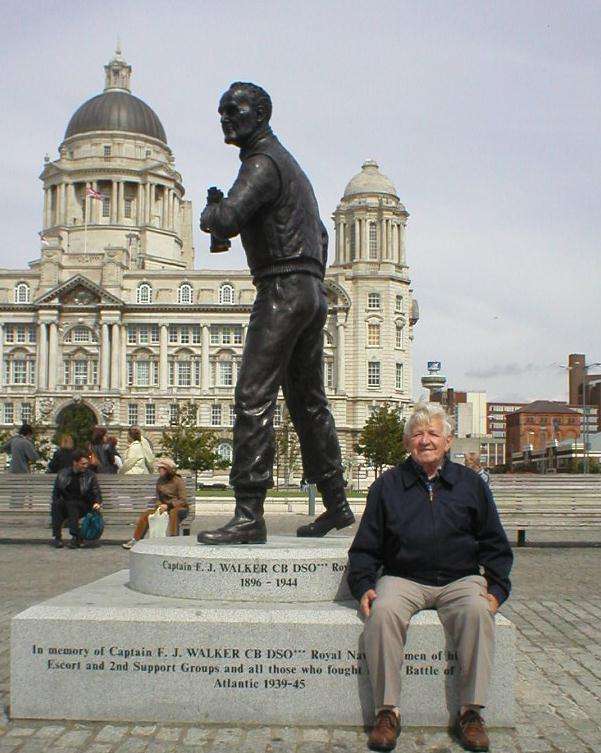 Lionel Irish sitting on the other side of the statue clearly showing the main inscription. |
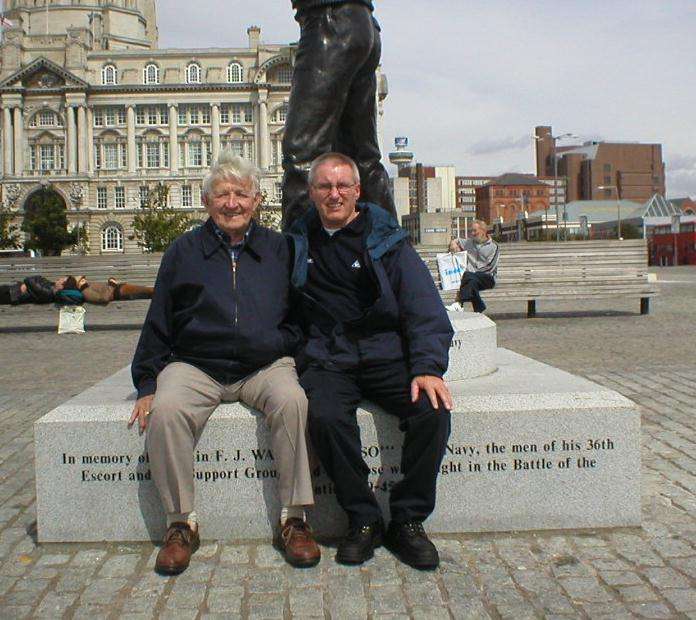 Lionel now joined by the son of one of those lost when Kite was sunk. This is Jerome McAreavey |
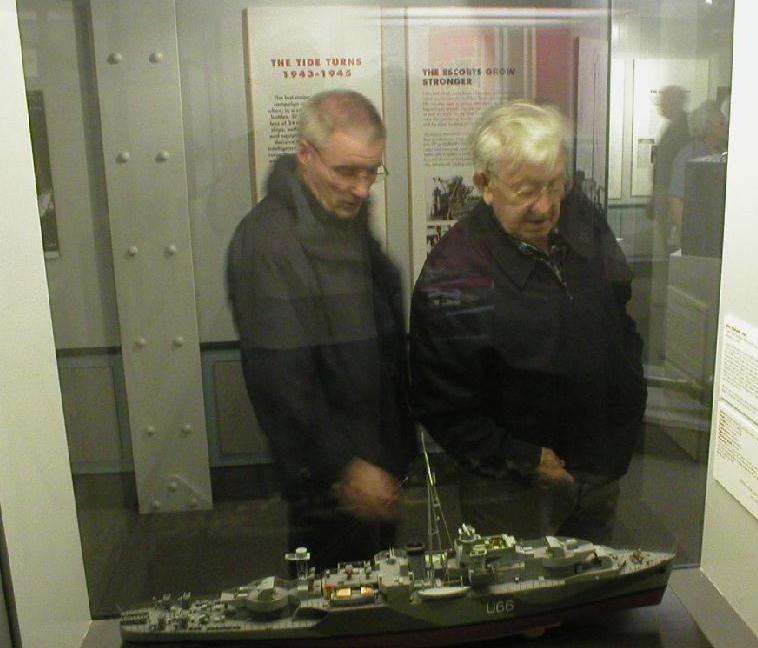 Later that same day, we visited the Maritime Museum to show Lionel and Jerome the Battle of Britain section. Here they are looking at a model of HMS Starling. |
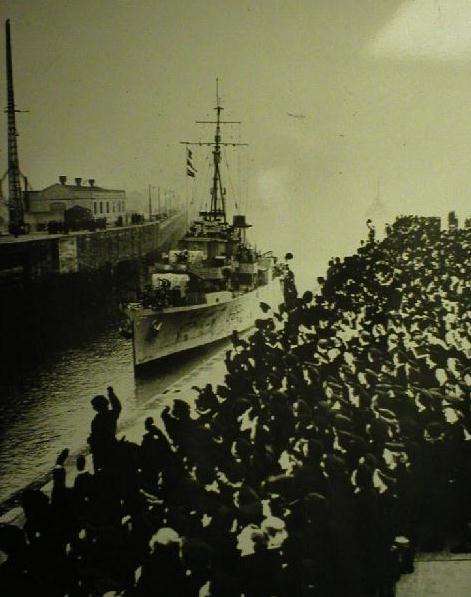 Museum image of HMS Magpie returning through the lock at Gladstone on the finale of the famous 6-in-1 trip |
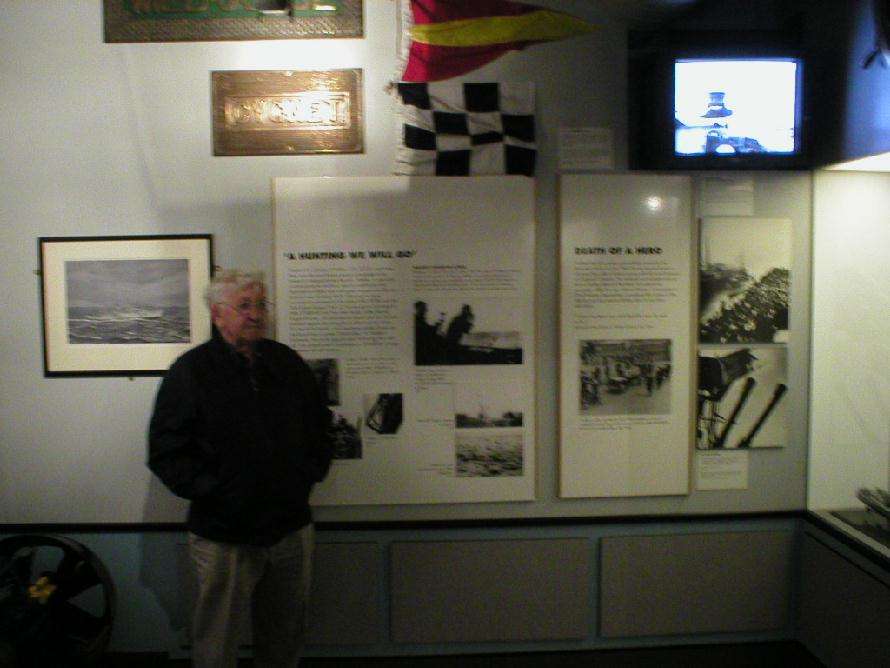 Lionel in the Walker section of the Battle of the Atlantic display |
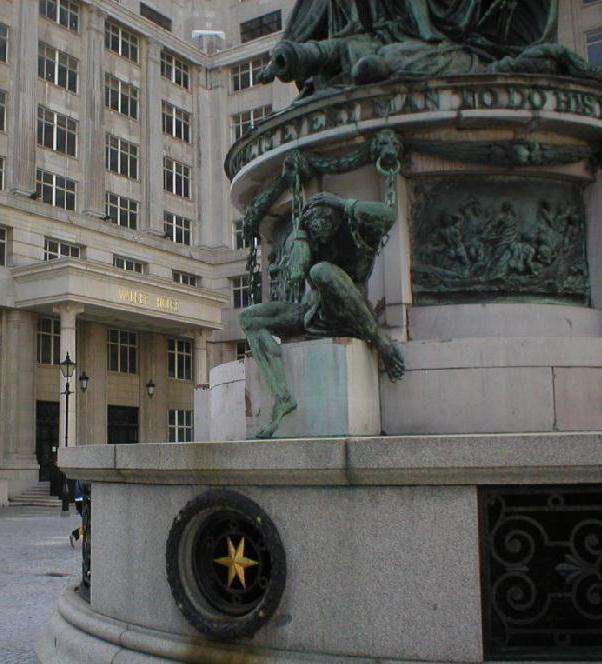 Walker House, in Derby Square, named after the Captain, in the foreground is the Naval Memorial "England Expects etc" is enscribed around the monument. |
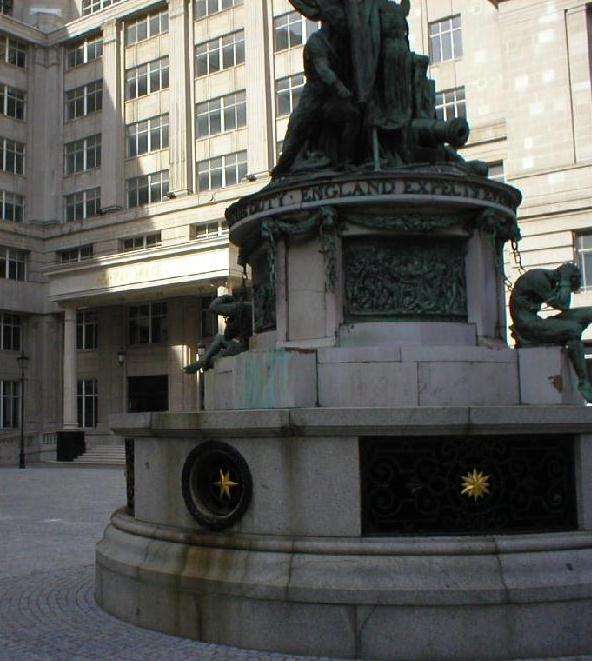 And on the opposite side of the square, Horton House, named after Admiral Sir Max Horton C-in-C Western Approaches |
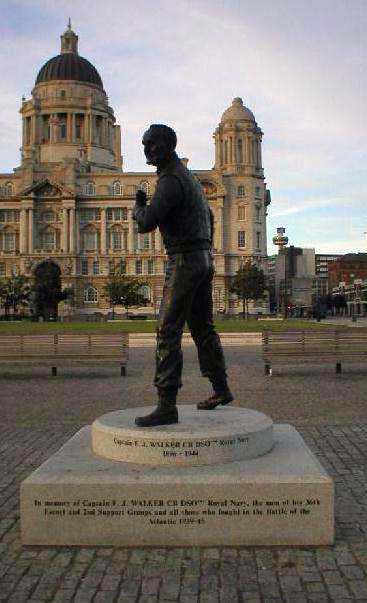 I took this image of Walker's Statue as the sun was going down on the Mersey on the anniversary of his death. |
 And then, from the other side, showing the sunset on the River Mersey, Wallasey being in the background |
| Saturday 10th July 2004 | |
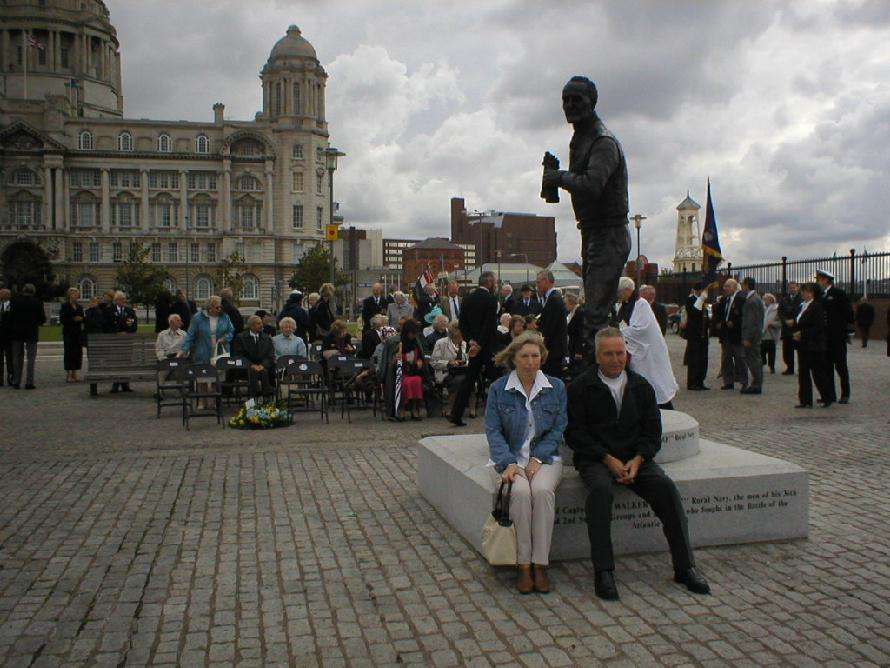 Starting to assemble, the guests for the handing over of Walker's statue to the safe keeping of the Council. Two members of the Webb family are pictured here. |
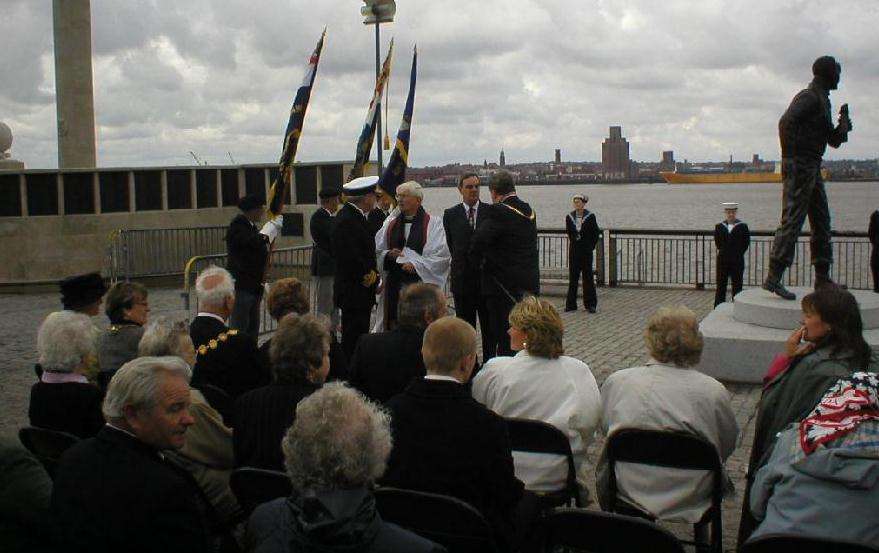 The Padre talks to Captain Pat Walker as Rear Admiral N Harris stands close by |
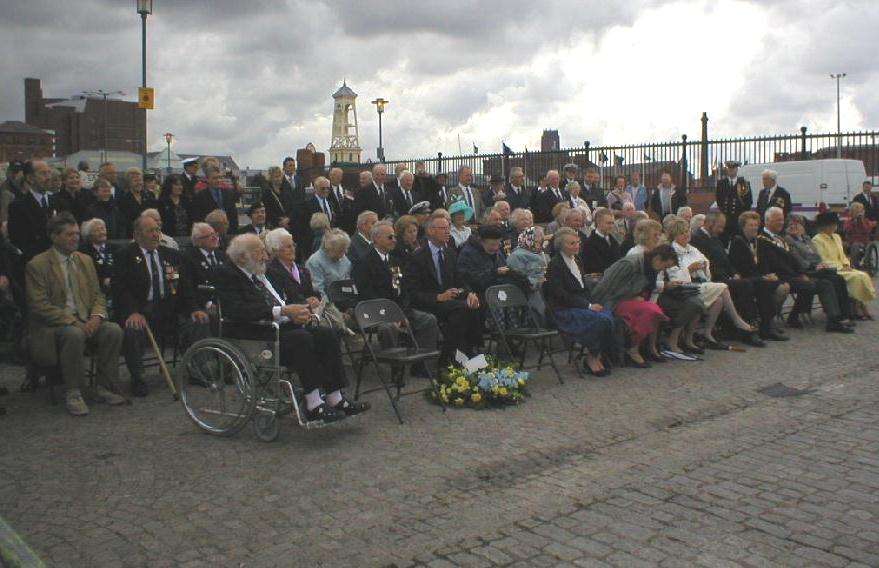 The beginning of the handing over ceremony and the gathered Walkers Old Boys and families. |
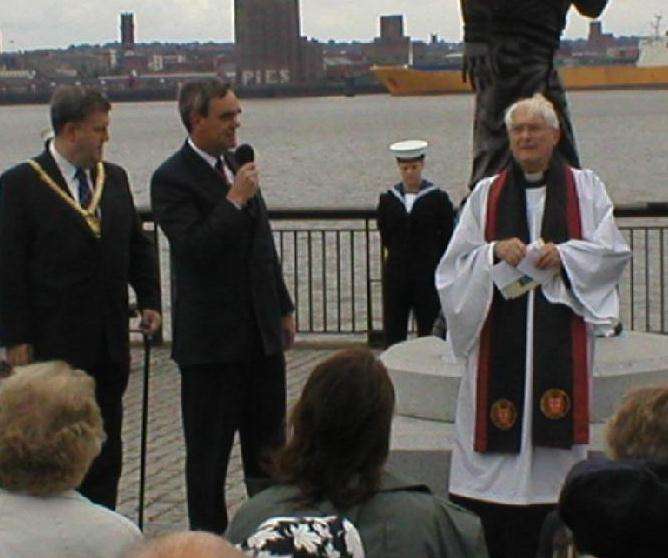 Captain Pat Walker RN saying a few word |
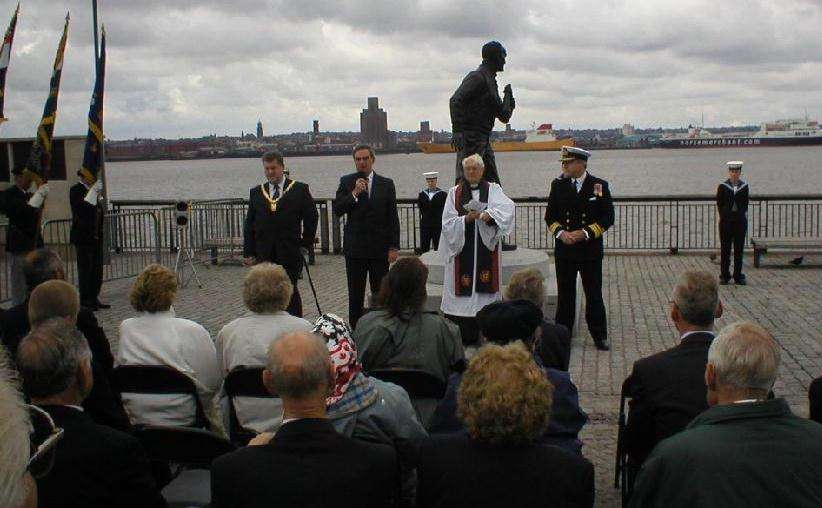 and again here |
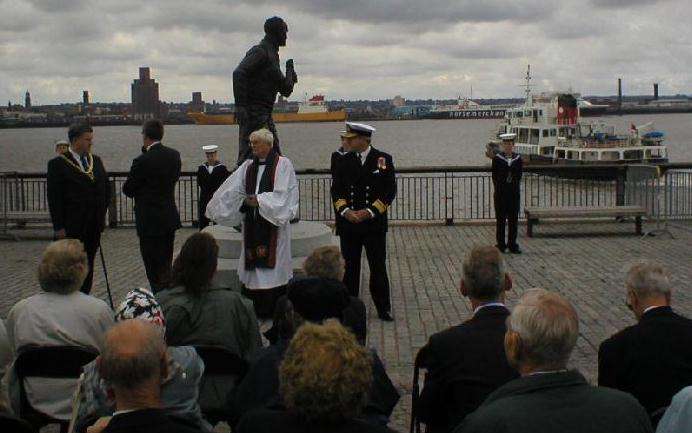
Handing over the mic to the Lord Mayor of Liverpool, who accepted
responsibility |
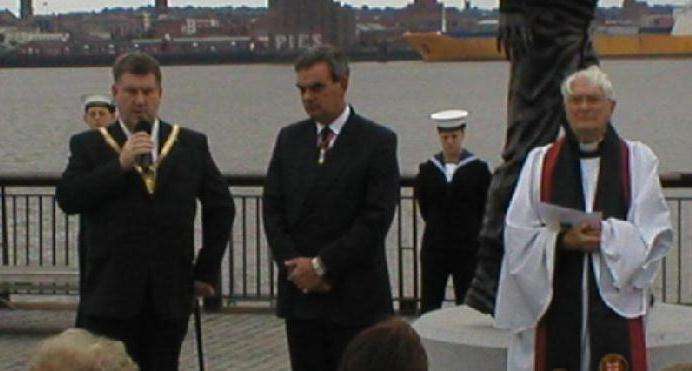 The Lord Mayor says a few words in acceptance |
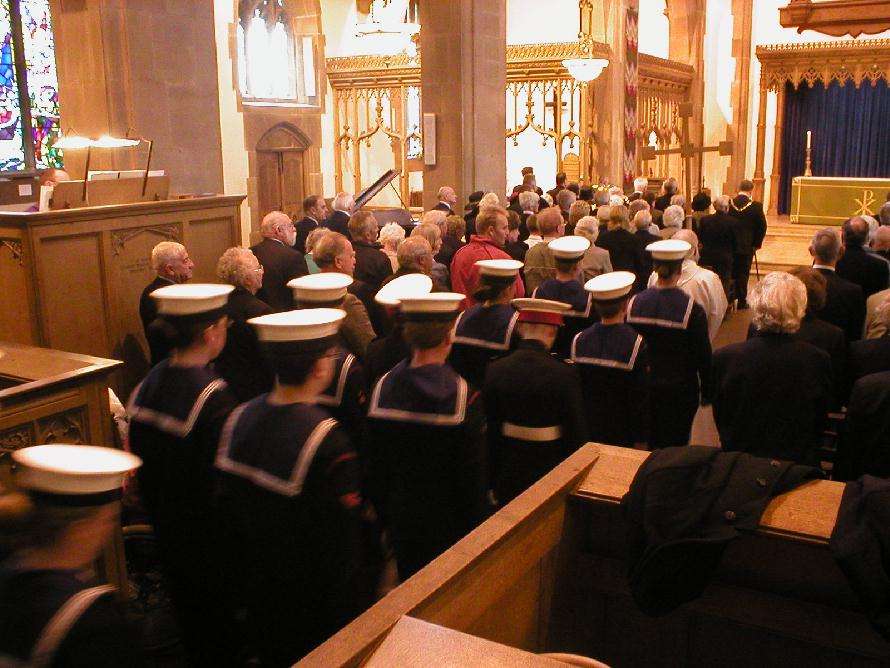 On to St Nicholas' Church for the Service. The entrance of the Sea Cadets of Bootle |
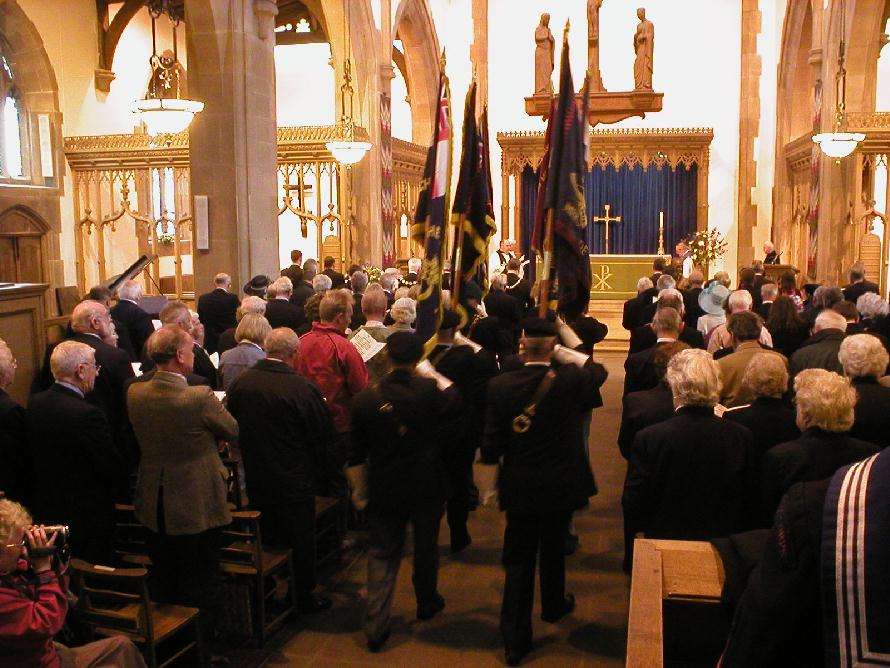 Followed by the standard bearers of CWOBA |
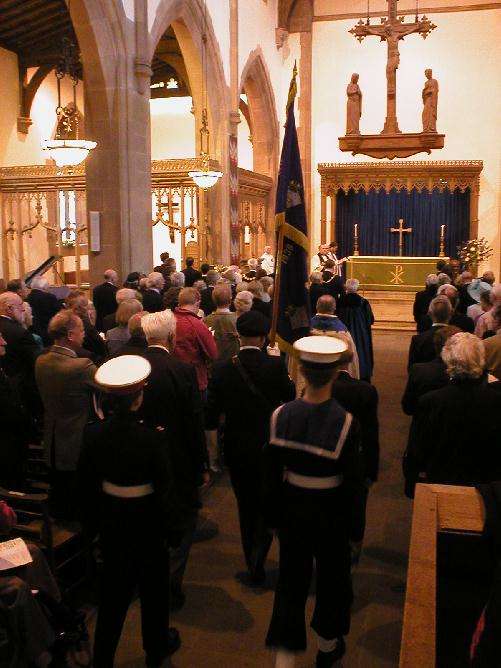 Followed by the Rev J Williams, MBE, RNR, Chaplain CWOBA |
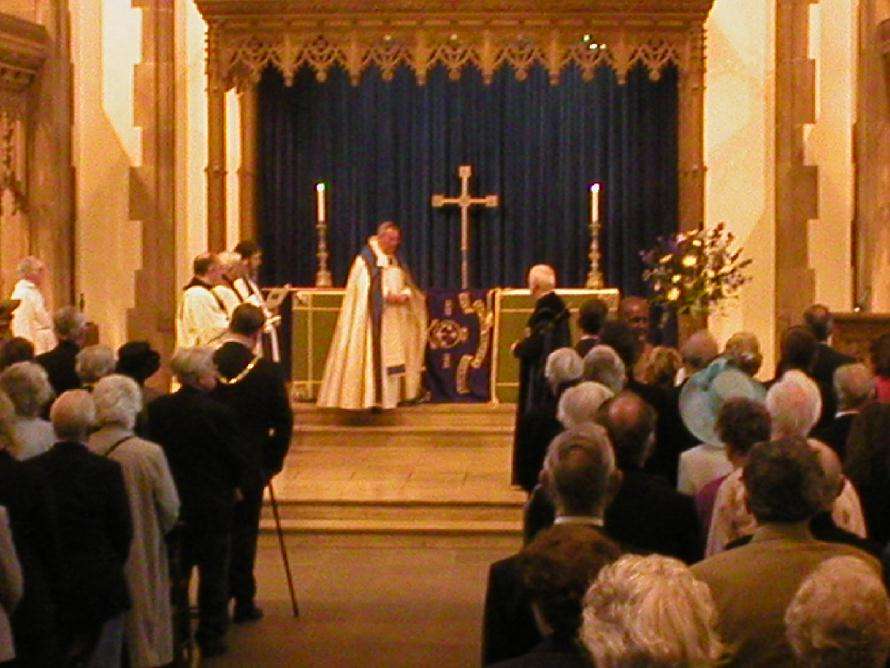 The Standard is laid across the altar |
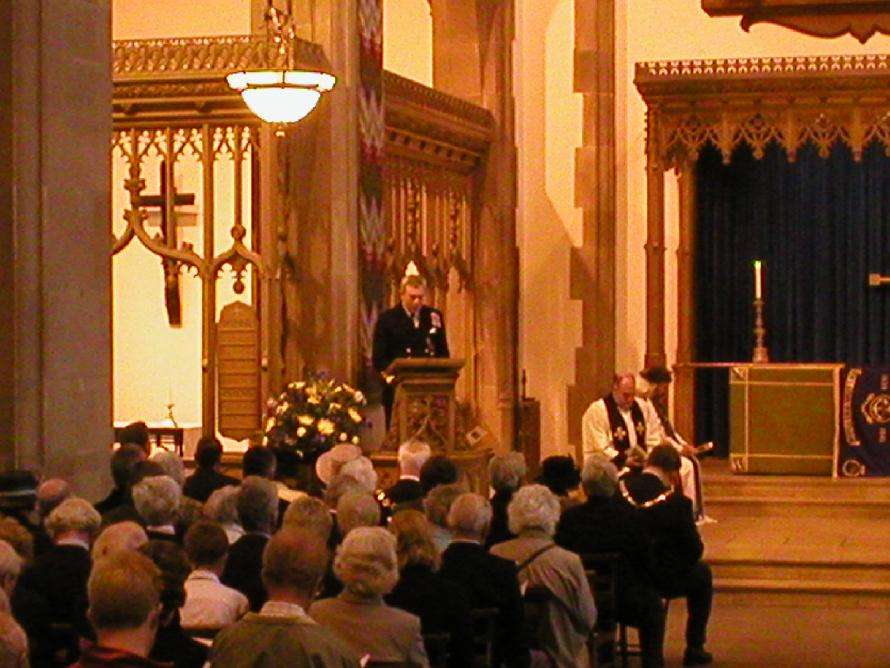 Rear Admiral N Harris MBE FOSNNI gives the same address as given by Admiral Sir Max Horton at the funeral of Capt Walker |
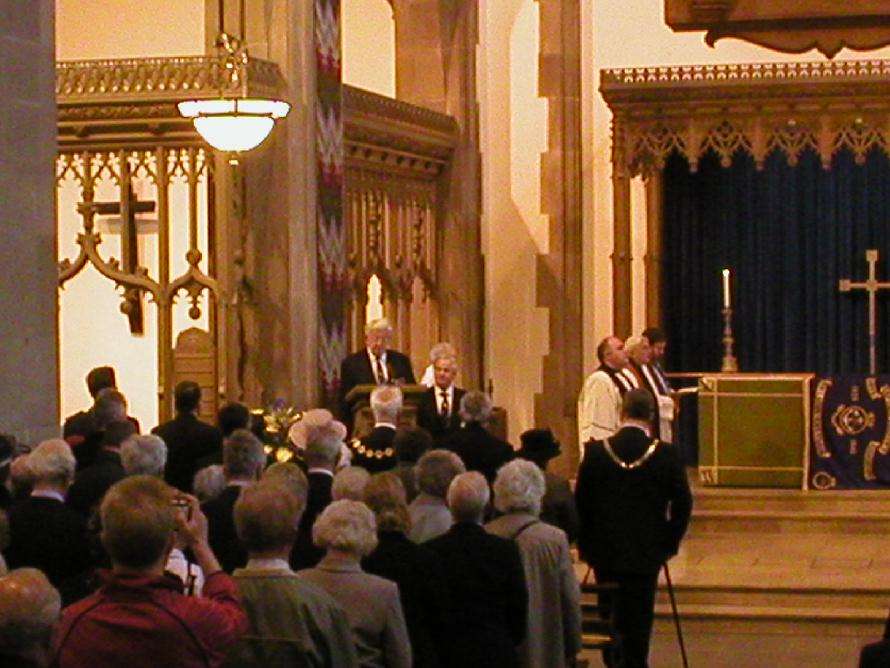 Lionel Irish, HMS Kite, reads the prayer of Sir Francis Drake, the Exhortation |
 then Capt Patrick Walker read The Farewell |
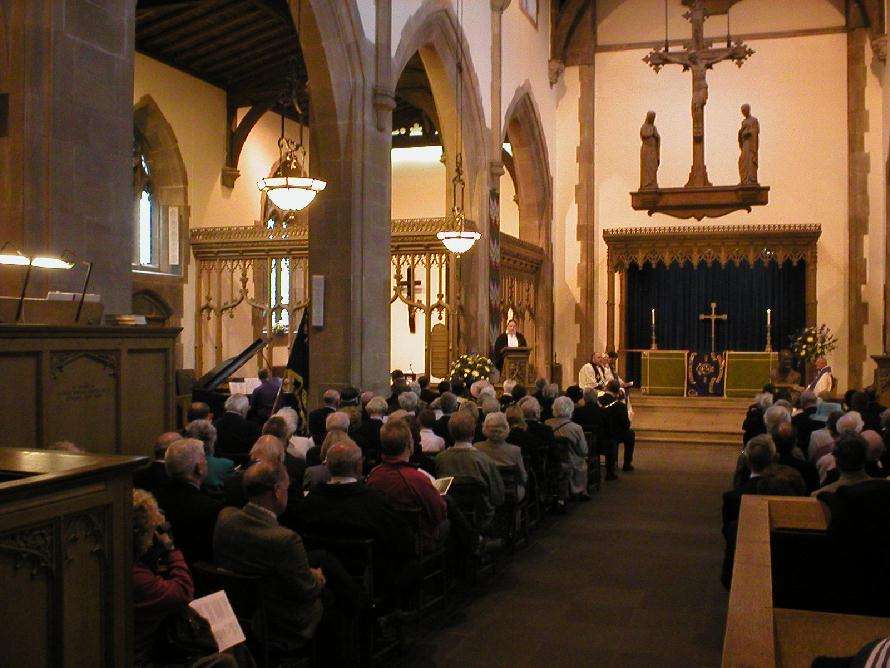 and Claire Davies, Durham University student, sang We'll Meet Again, made famous by Vera Lynn in WW2. |
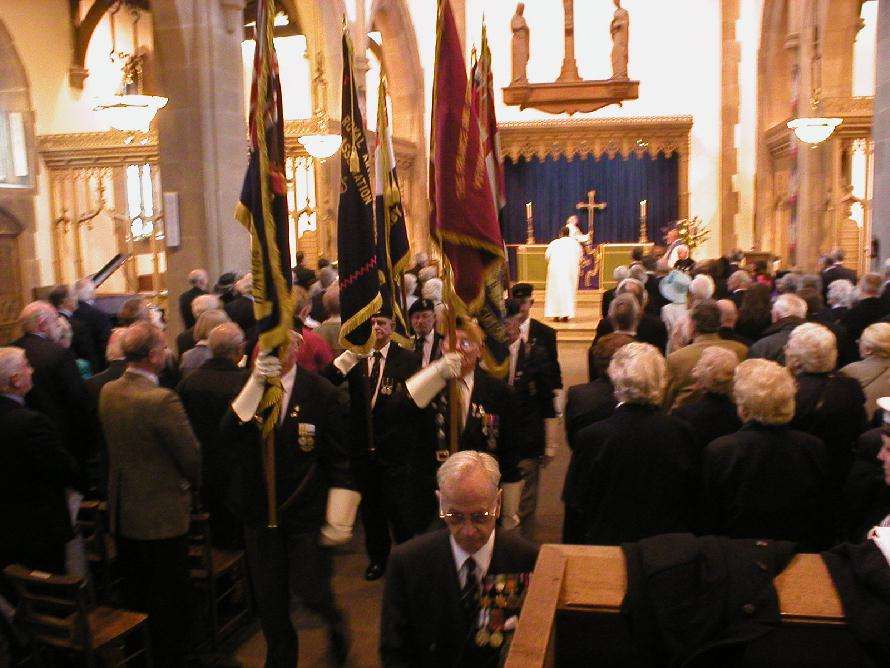 The Service over, CWOBA parade from the Church, Standards high |
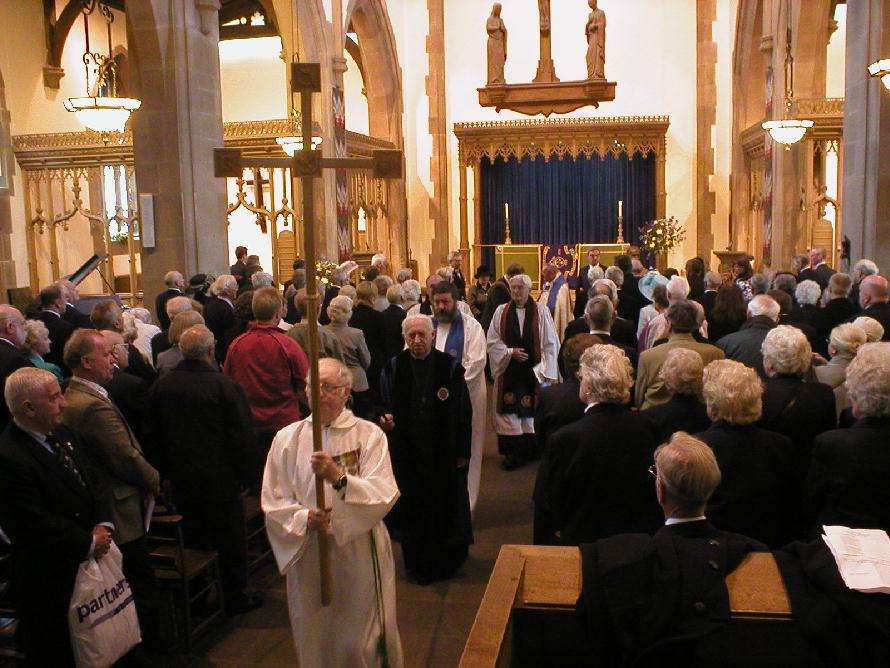 Followed by the Church dignitaries |
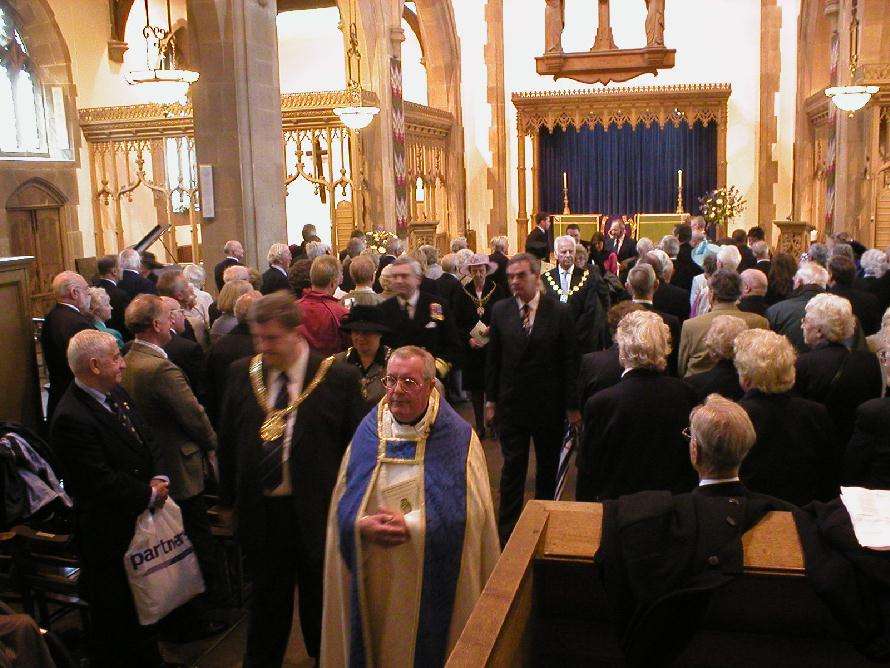 then Admiral Harris, Capt Pat Walker & families |
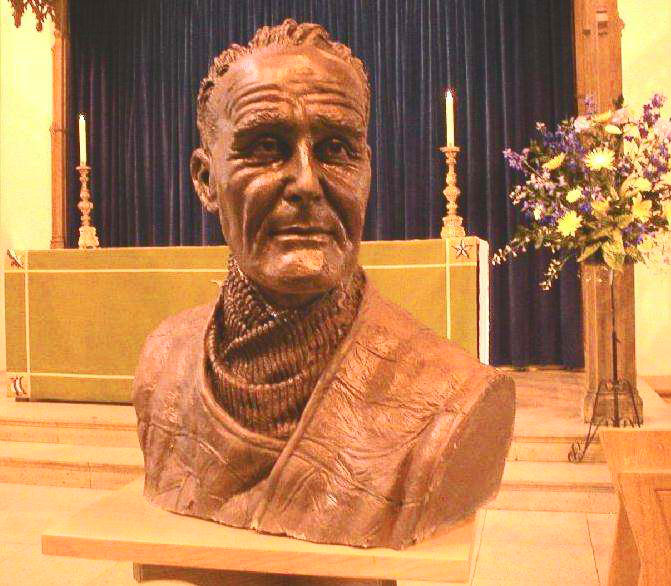 A bust of Capt Walker which was on display by the altar during the service |
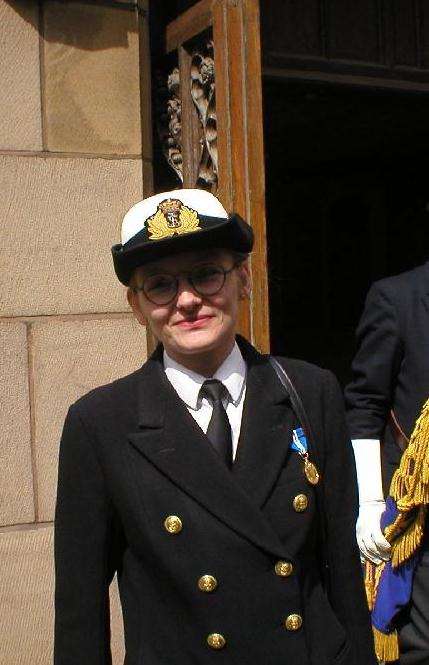 This lovely lass, Sea Cadet Officer, was responsible for playing the Last Post during the Service |
| On to Bootle Town Hall | |
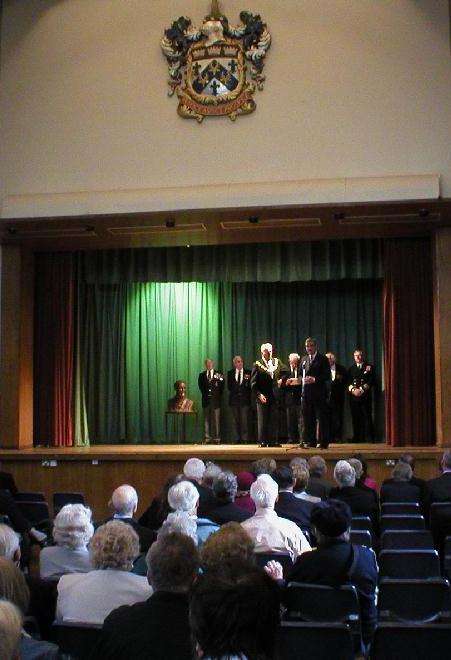 Capt Pat Walker addresses those present on the handing over of the Standard to the Deputy Lord Mayor of Sefton, for the safe keeping by the people of Bootle |
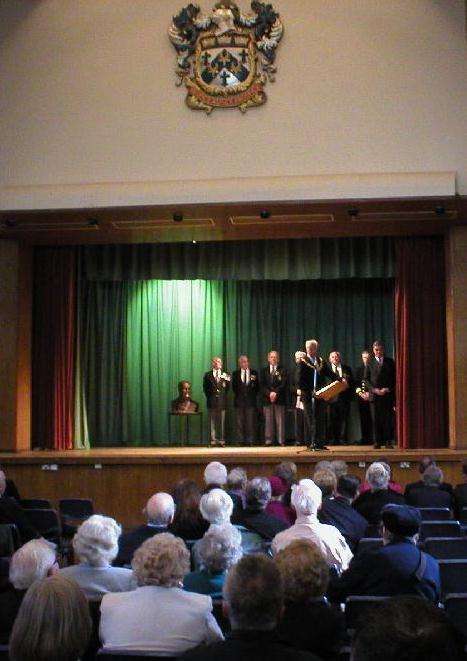 Deputy Lord Mayor accepting a painting of HMS Woodpecker on behalf of the people of Bootle |
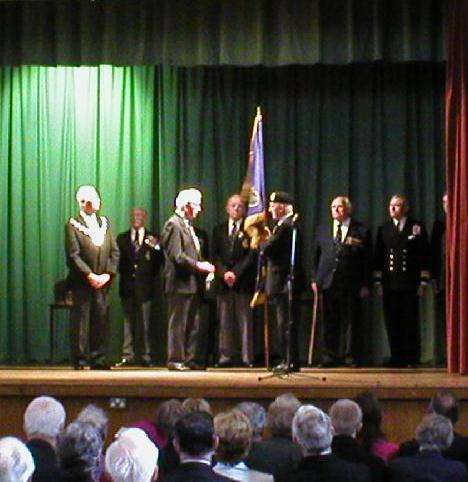 The process of the handing over the Standard begins |
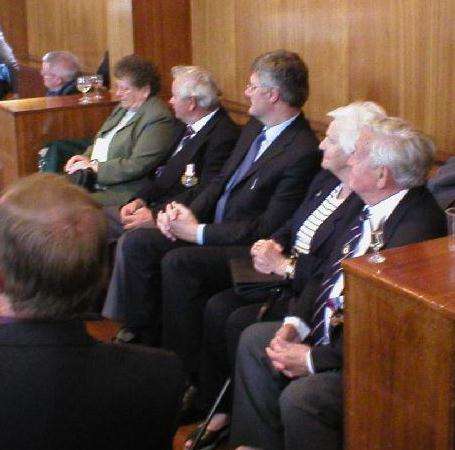 The HMS Kite representation sits watching the proceeding |
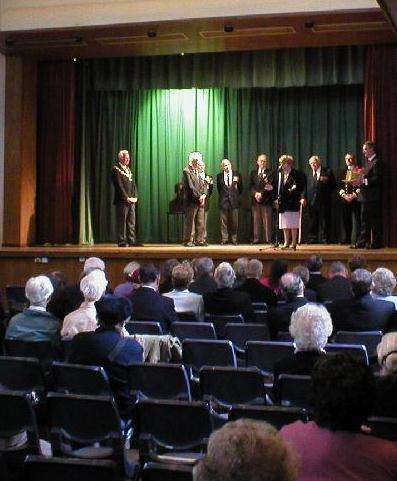 Secretary to the CWOBA, Pat Marsh accepts some gifts for her sterling work over the years. |
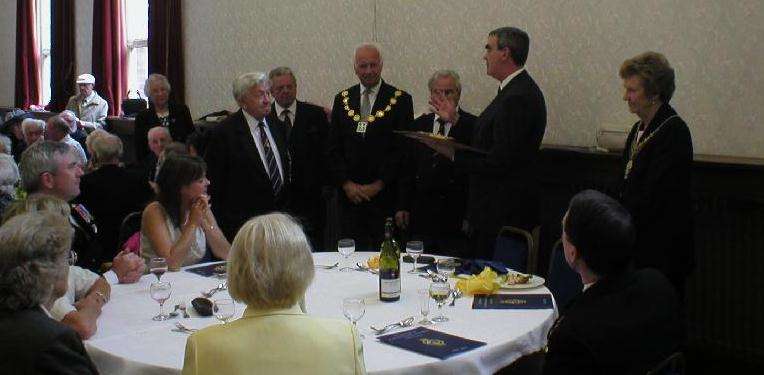 Ray Holden & Lionel Irish present Capt Pat Walker with a plaque commemorating the role played by HMS Kite |
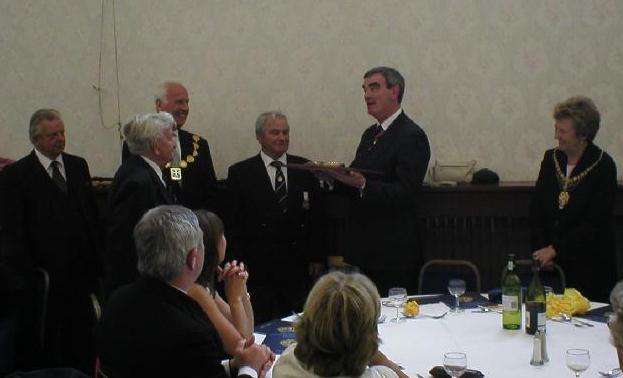 Which Capt Walker very happily accepts. It was a surprise to him, he did not expect such a fine gift. |
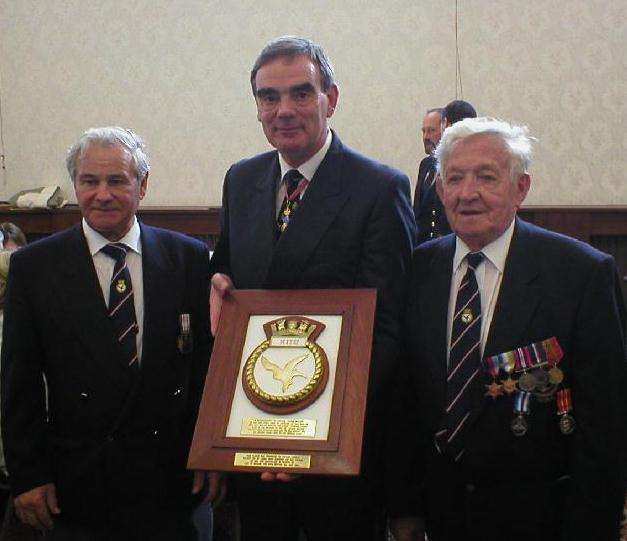 |
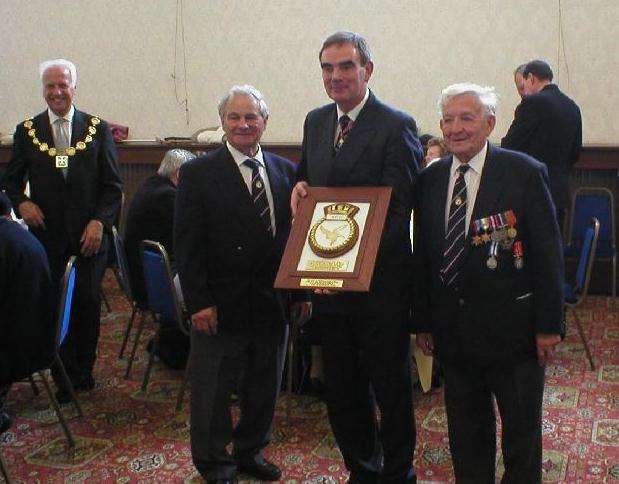 Joining in the image is the Deputy Lord Mayor of Sefton |
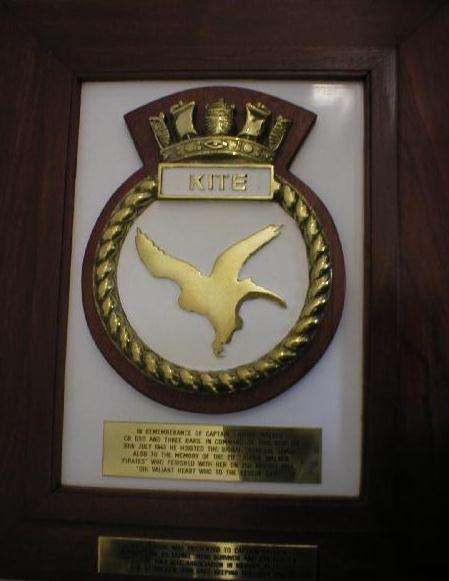 The HMS Kite Plaque |
 Alan McMillan talks to Capt Walker at the Starling section in the Council Chamber. The General Chase can be just seen behind Capt Walker |
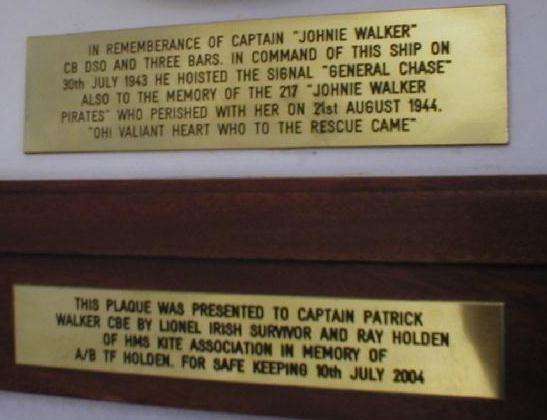 The inscription contained on the plaque. |
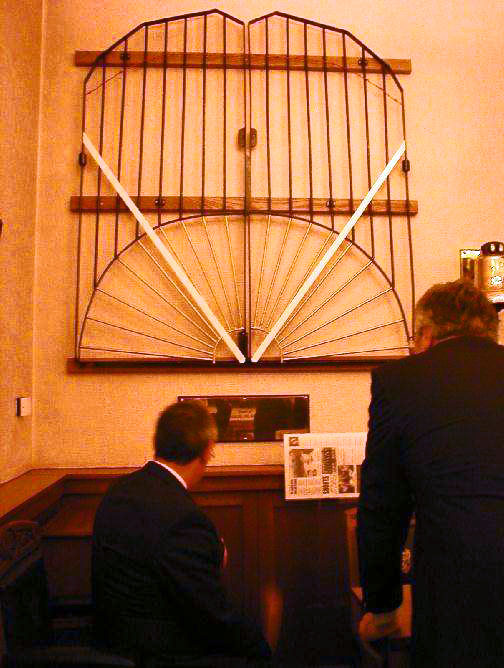 The Gates to Captain Walker's "Flotilla House". I forgot to take an image of the details below. Hopefully somebody can fill me in on the details behind this section? |
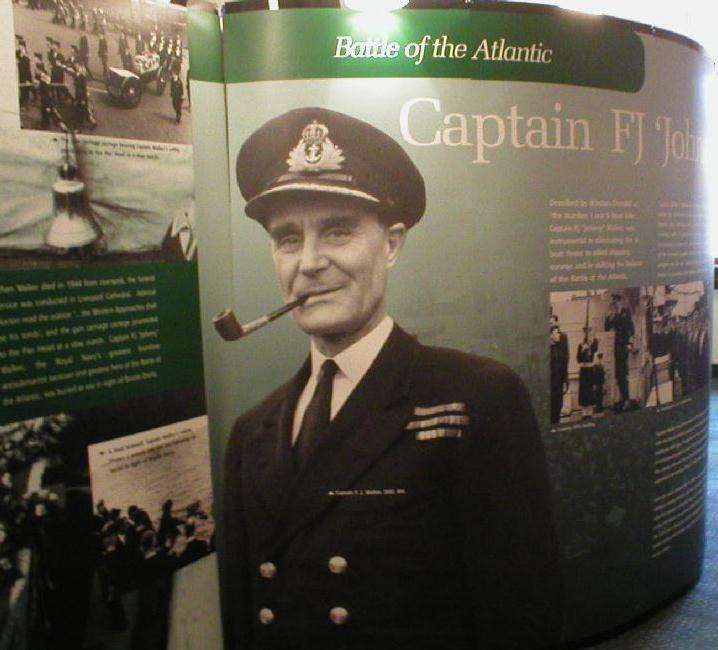 A section of the Battle of the Atlantic exhibition in the room adjacent to the Council Chamber. |
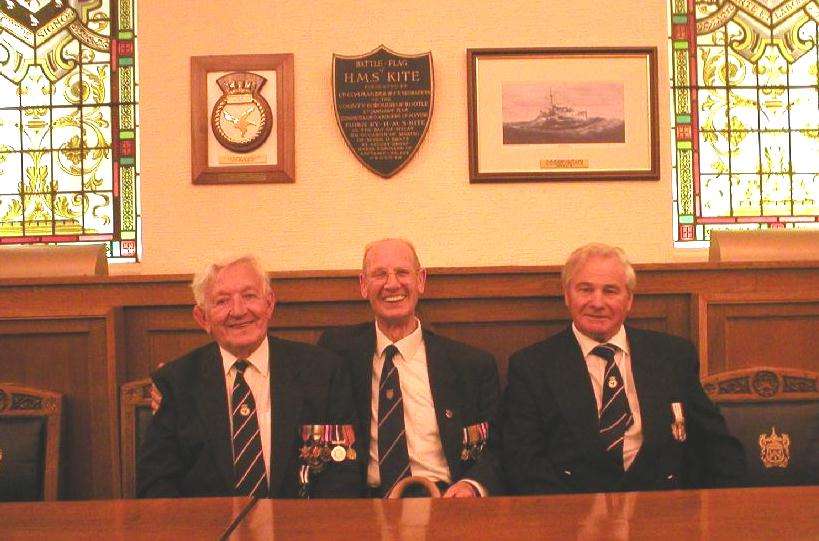 Lionel Irish & Bob Drew, both HMS Kite. Bob served aboard Kite from Aug 43 - Dec 43. Ray Holden on the right |
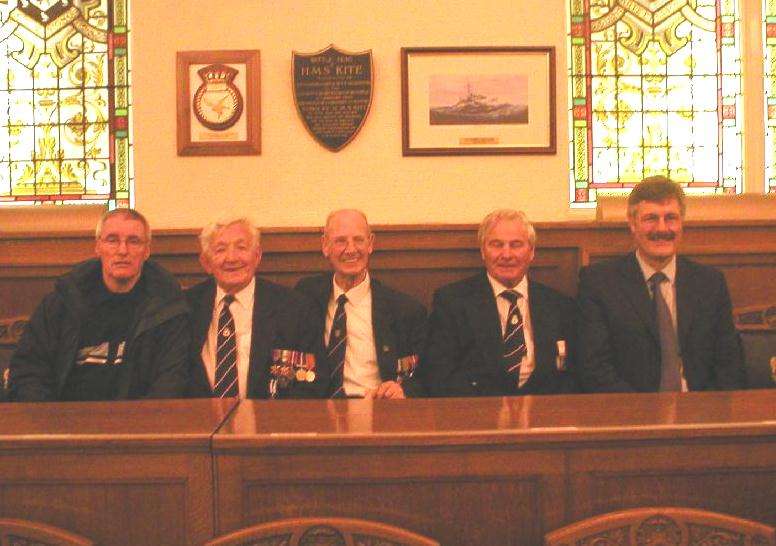 Joined either side by Jerome McAreavry and Alan McMillan |
 Order of Service |
History of Church On the morning of 21 December 1940 the church of Our Lady and S. Nicholas stood gutted by fire following a wartime raid; only the tower, adjoining vestries, and the offices survived the building of the new church began in March 1949: was consecrated on the Feast of St Luke (18 October 1952. The following is a brief history before 1940 and a guide to the chief futures of the present building. The ancient parish church of Liverpool was St. Mary’s Walton on the Hill, 3 miles ( 5km) from here. In 1699 Liverpool, with a population of about 5000, was created an independent parish with two churches: Our Lady and S. Nicholas (often called the "old Church" or simply St. Nicholas) and a new parish church of S. Peter. In 1734 the first of many daughter churches was built; by 1865 there were 27 in the parish, which by then housed about 275,000 people. Since 1916 Our Lady and S. Nicholas has been the Parish Church of Liverpool. S. Peter’s, which stood in Church Street, was demolished in 1922 The story begins in the 13th century. Liverpool received its charter from King John in 1207. A small stone chapel known as the Chapel of S. Mary del Key probably stood close to the site of the present tower overlooking a quay on the River Mersey by 1357. In the years 1355-61 a new chapel, dedicated to St. Mary and St. Nicholas, was built on land ranted to the burgesses by the Duke of Lancaster. During a plague in the town in 1361, the Bishop of Lichfield and Coventry (whose diocese then included North-west England) licensed the burial ground, and the following year the chapel itself was consecrated. By the late 15th century a north aisle, the same size as the nave, had been added and three chantry altars had been established each with its own priest paid for by a wealthy patron for whose soul he was to pray. In 1515 a fourth chantry was founded. Chantries were abolished at the Reformation and the building was by stages adapted to Protestant forms of worship. Between 1673 and 1718 the building was further extended piecemeal and galleries were built to house the increasing population. in 1746 a spire was added to the rower. |
|
In 1775 the parish took the extraordinary decision to rebuild the walls of the church but to retain the existing galleries which were jealously guarded by the congregation who paid pew rents. The new roof was supported by classical columns set on the medieval bases. The outer walls of the rebuilt church (four feet longer than the old one) occupied the same lines as the present building. Despite the many new churches in the city no opportunity was taken to replace the ‘Old Church’ with a wholly new building. There were repeated warnings that the spire was unsafe, and on 11 February 1810, as the bells were ringing and the people assembling for Sunday morning service the steeple crashed into the nave killing 25 people (21 of them aged under 15, mostly girls from the Moorfields Charity School) and injuring as many others. Between 1811 and 1815 the new tower and lantern, built to the north of the old one, was erected to the designs of Thomas Harrison of Chester; the remains of the old chapel of S. Mary de Key, long used as a boat house. and a tavern, were demolished. There were improvements to accommodate liturgical changes, notably in 1851-1852, and the office block (now the Parish Centre) was built in the 1920s; otherwise the building was unchanged between 1815 and 1940 — much loved but architecturally undistinguished except for the tower. In the new church the architect, Edward C. Butler, effected some major changes. The altar is at the west end below the tower, not at the east where, in common with universal Christian tradition, the old altar had been. Secondly, there is a focus on the Sanctuary rather than on a prominent pulpit; the old galleries, designed to accommodate large congregations, have been dispensed with. These changes reflected not only smaller congregations but a long established Anglo-Catholic tradition with an emphasis on the Parish Eucharist. Thirdly, the present nave, at 46 feet (14m), is higher than its predecessor. And finally, the Narthex (entrance vestibule) with the organ and Refectory above further reduced the main seating space. Thus, although the floor area of the new church is the same as the old the use of the space inside is very different.
The Narthex |
The
Cattrall Scrcens
The Rood
The Nave and Sanctuary
The Organ
Chapel of S. Peter |
|
Maritime Chapel of St Mary del Key
Building Materials
The Tower |
The Bells
Christ upon an Ass
The Churchyard |
| Bootle Town Hall Council Chamber | The bell of HMS Starling is rung to bring the Council to order |
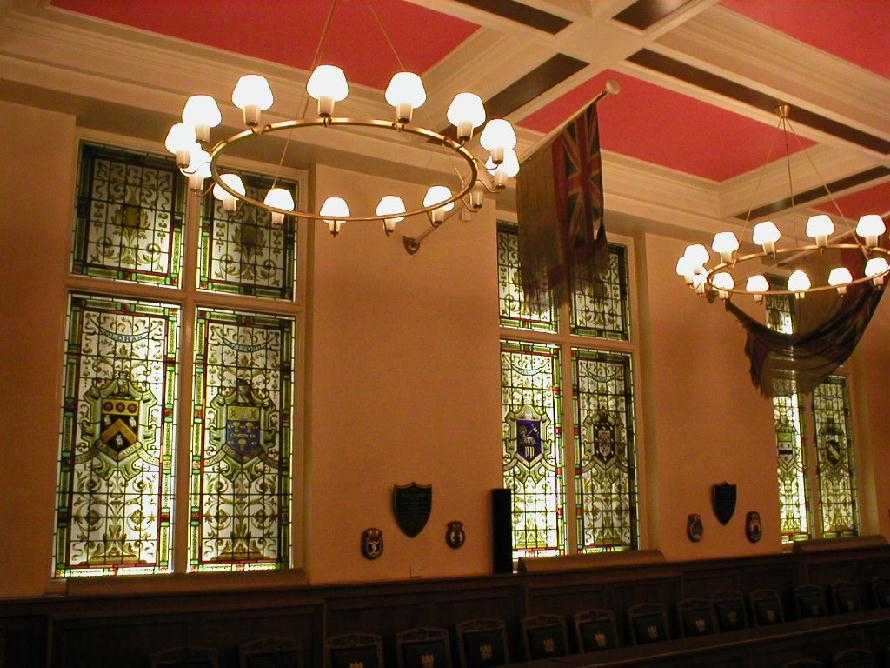 |
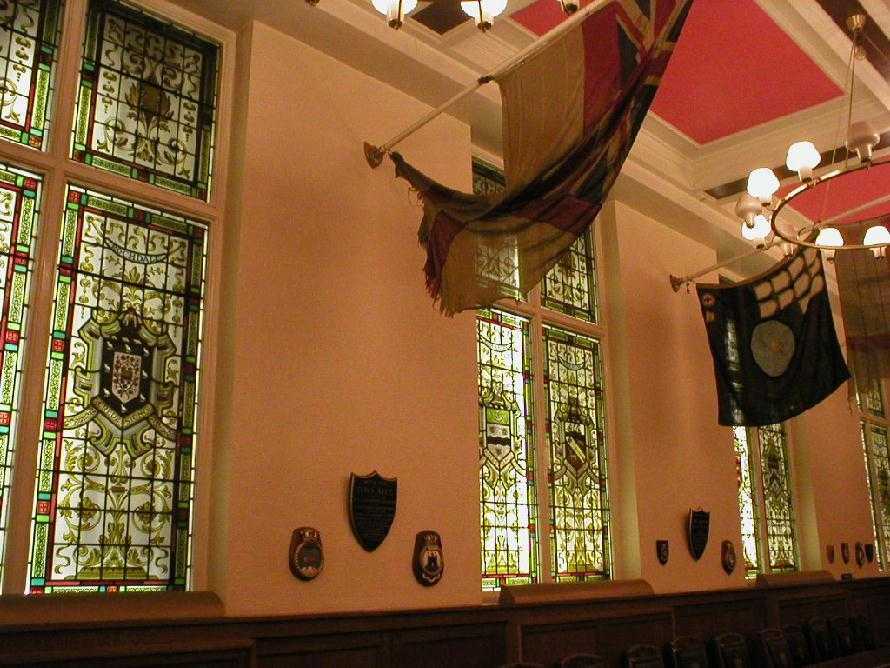 |
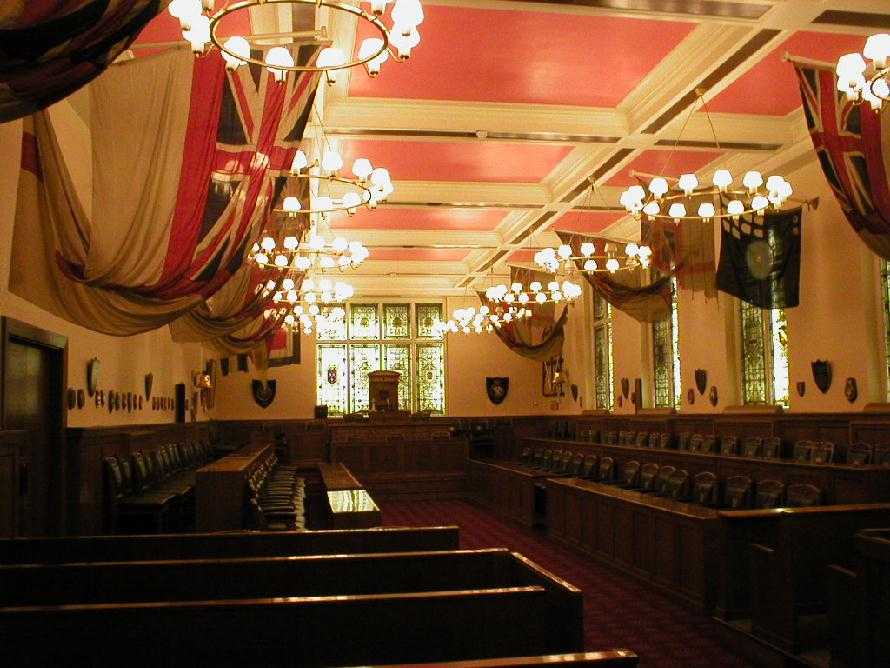 |
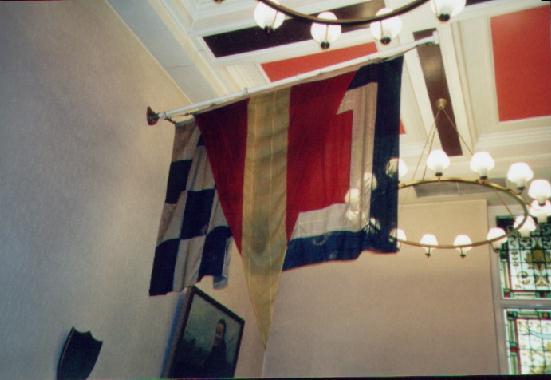 |
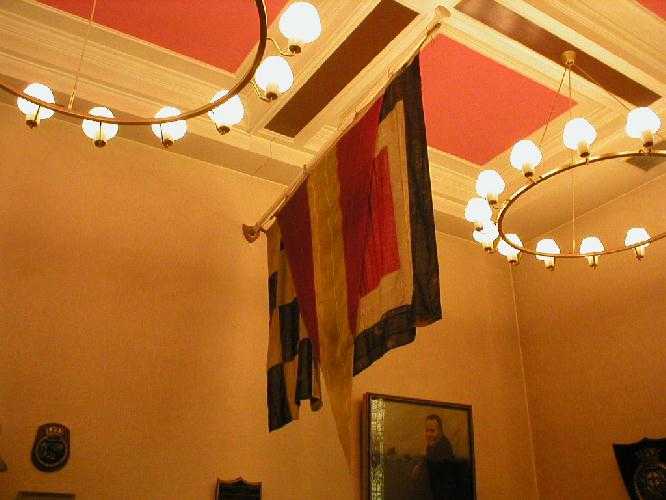 |
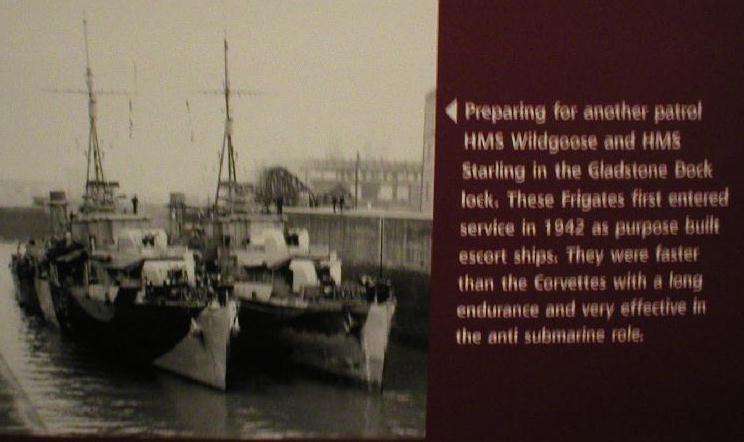 |
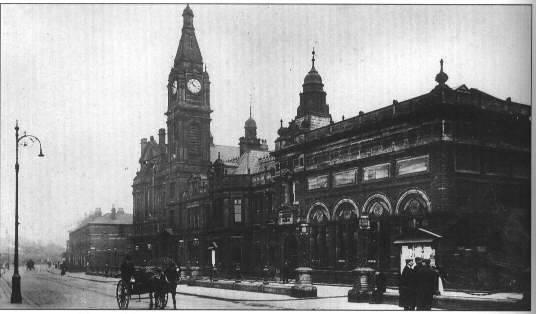 |
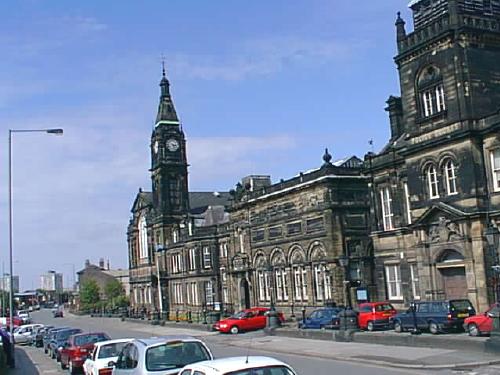 |
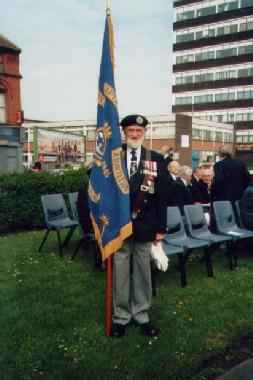 Bob Saxby |
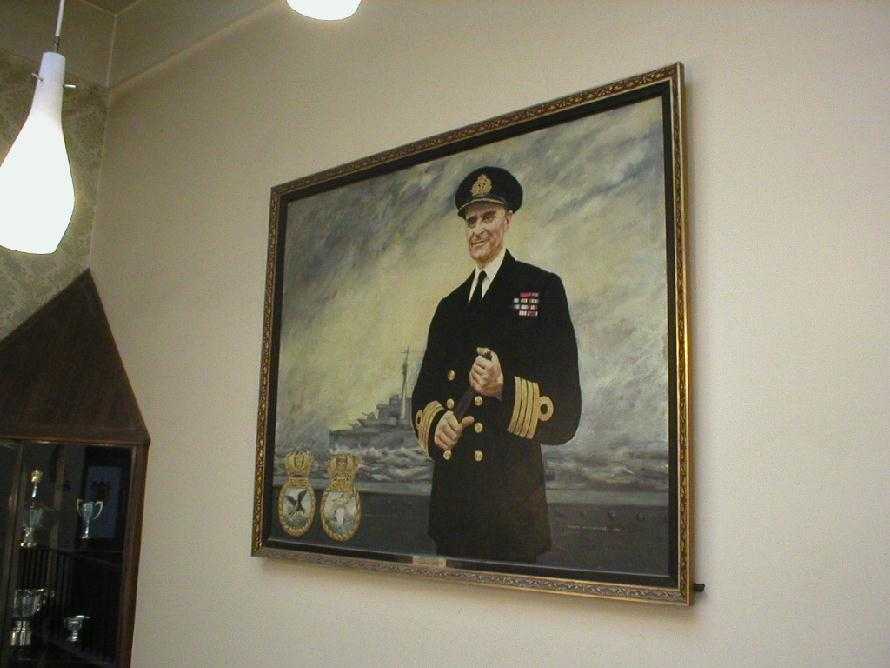 At the head of the main staircase |
 Captain Walker also commanded HMS Kite on occasions. See below |
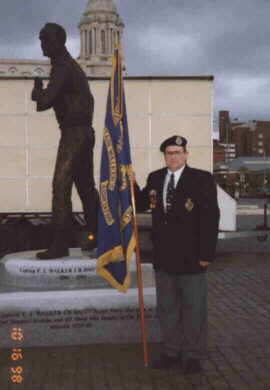 |
http://www.timbosliverpool.co.uk/
http://www.bbc.co.uk/liverpool/localhistory/journey/underground/western_approaches/tour.shtml
http://www.liverpoolmuseums.org.uk/maritime/exhibitions/boa/home.asp
* A notable absentee from the CWOB Standard is HMS Kite, on which Walker also
commanded, albeit temporary, on more than one occasion. Personally I find it an
insult to the brave lads of HMS Kite.
Kite was Walkers prefered command when
his own ship was unavailable due to repairs, overhaul etc